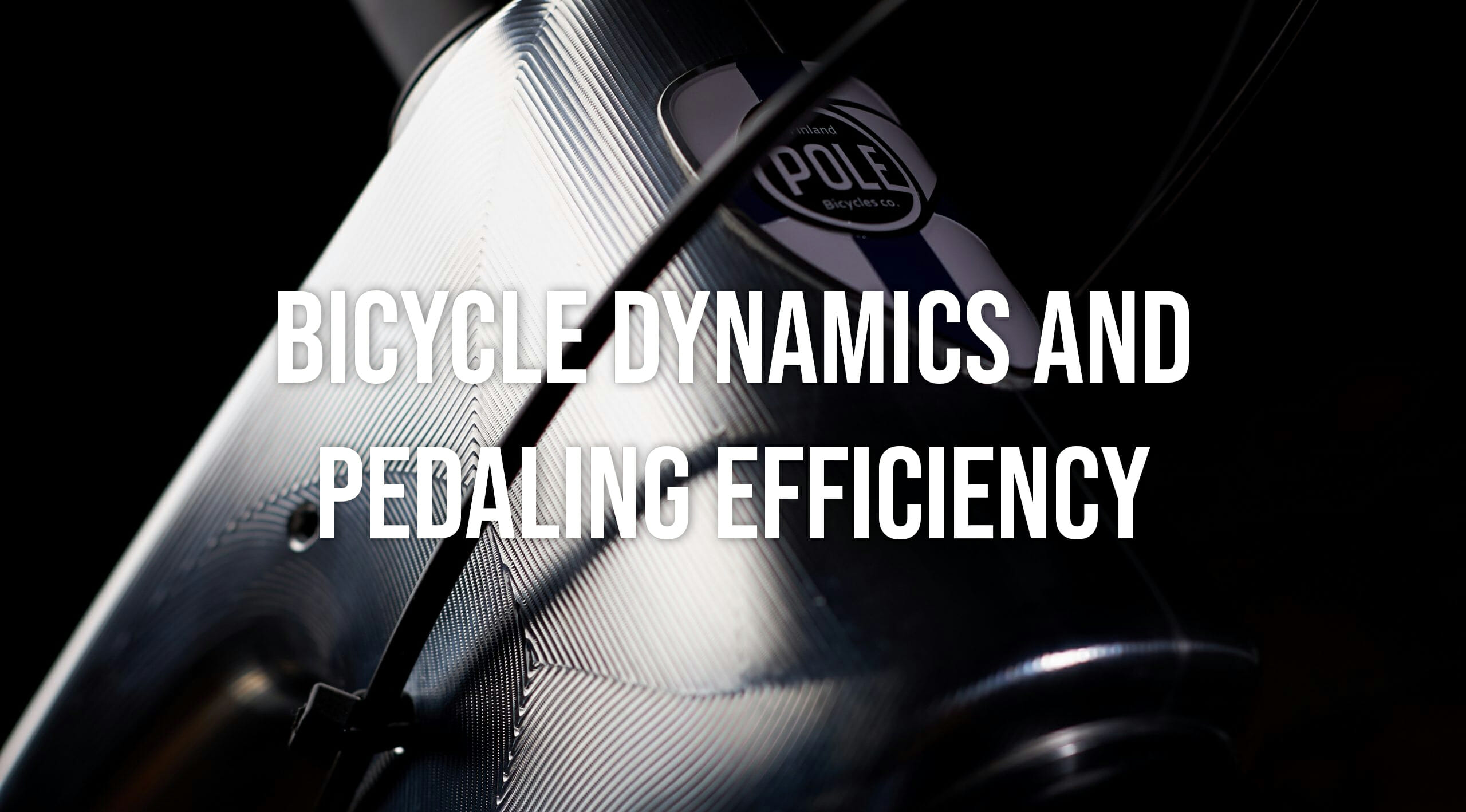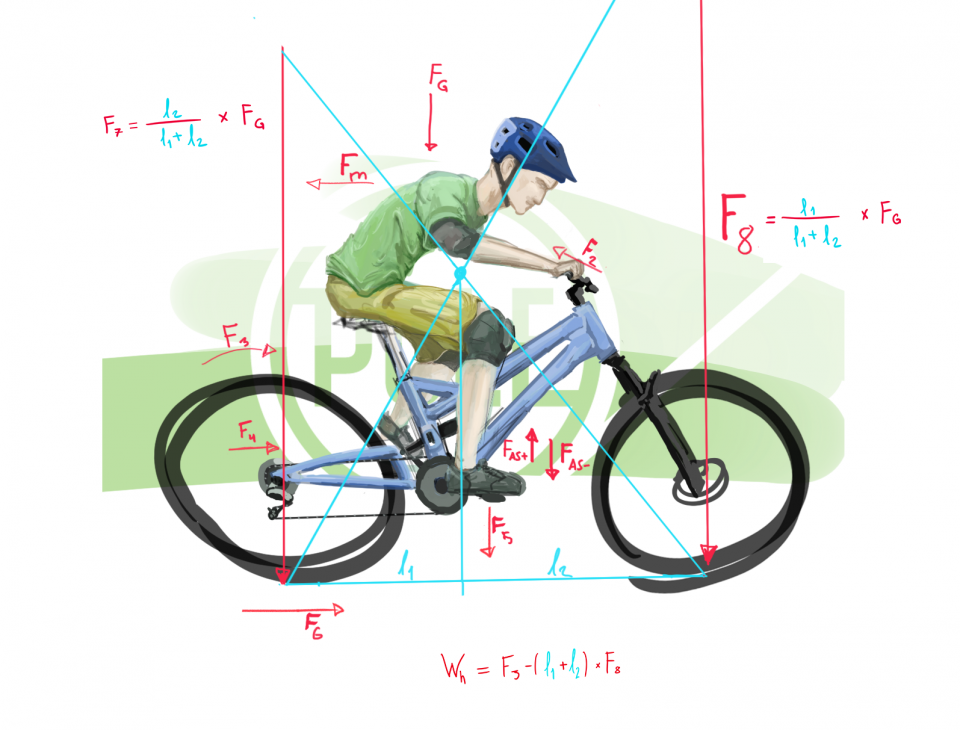
Bicycle dynamics and pedaling efficiency
Pedalling efficiency in suspension bike depends from many variables. There’s nothing really special about the physics to person who is educated in physics and mechanics. If you want to market something the message has to be simple. That’s why companies, media and riders have made the bicycle dynamics very confusing. The full suspension market is also very young and there is a lot of young persons for market the stuff, which makes it tending to make stuff sound cool.
I want to break this loop by explaining the bicycle dynamics. The rider is the engine and the bicycle is a vehicle, that’s it. There is no magic. I’ll rule out the rider skill because a good rider can adapt to different systems and ride fast with any bike. In the previous blog I explained how the Anti Squat works. Anti Squat is a term for suspension engineers to determine how much the suspension mechanism itself is resisting suspension compression. AS resists the pedalling forces from compressing the the suspension. We need to look at the loads and forces which are involved in the cycling.
Weight and suspension
In the first part here I’ll rule out rider weight distribution and I’ll just concentrate on the up and down direction forces. In bicycle the engine is the rider. In any vehicle the motor needs to be attached to the frame. On bicycle the rider is attached from the handlebar, and from the pedals. When rider is creating force the support comes from the handlebars only. If the rider is not holding the handlebars the rider is using some of his energy to lift himself up when accelerating. This can be implemented by trying to accelerate stationary bike without hands on the handlebar. If the rider pedals optimally he’s body remains stiff and only the legs are doing the job.
When rider is on the bike the rider mass creates a force down (because of the gravity) to the bike and the bike creates a force back (Newton’s third law) . In suspension frame the suspension compresses as much the spring is set. In the fork the leverage ratio is 1:1 (without leverage) and in the rear the optimal leverage ratio is between 1:3 to 1:2 and the leverage ratio in rear is changing through the travel because all the bikes are using rotary leverages. When bicycle accelerates, brakes or hits an obstacle the mass of the rider and the bicycle are resisting the change of the speed. The suspension is designed to absorb the hits and convert the energy of the mass and speed to heat. The forces and the bicycle works with these rules when bicycle is coasting.
Pedalling forces
When rider pedals the bike he’s creating forces from his body with muscles which get energy from food. The rider takes support for the pedaling from the handlebars which are attached to the frame through fork and headset this makes the front triangle and the rider together a closed system. The force transferred to the pedals create a force to the rear wheel through chain and the force is delivered to the ground by wheels and tires. All the energy can not be delivered to the tire because there’s friction from the chain and the bearings and the frame is twisting the energy to heat as well.
Weight, suspension and pedalling forces
Now we are getting to the interesting part. Because we are talking about a mountain bike it’s not reasonable to assume that the bike is traveling an smooth surfaces. There is always a bump or two on the way and this is why the suspension is there for. There is two scenarios when the rider is pedalling. 1. Accelerating 2. Keeping up the speed. Every pedal stroke is accelerating the vehicle because the pedalling motion is an oscillating motion and the friction from the world around is slowing the bicycle down all the time. The more continuous is the output force, the the better pedalling technique rider has. In uphill, the rider is constantly accelerating the bike on every pedal stroke because the bicycle speed is dropping between every pedal stroke. In our experiments (and the basic physics) the rider and the bicycle loses energy most is when accelerating.
Where the energy is lost in pedalling
1. Mass resits the changes in movement.
2. Suspension is compressing (Anti Squat <100%) and generating heat from the damper
3. Suspension is extending (Anti Squat >100%) and the force is used to lift the rider from the SAG position
4. Frame is losing energy in friction and flexing
5. Bad pedalling technique (fe. hip is rocking sideways)
How suspension works
The idea in suspension is to eliminate the obstacles effects to the rider mass as less as possible. Spring carries the load and the damper takes out the unnecessary movement. If the spring is too stiff compared to the rider mass, speed and the strength the suspension can not compress enough to use it’s full potential. If the spring is too soft the suspension doesn’t carry the load and the suspension sinks too deep in it’s travel. When this happens there is not as much travel in suspension to use and the damper is not working on the optimal area. If there is too much damping the suspension converts the speed to heat. If there is not enough damping the obstacles effects the rider mass and speed slows down. There is a certain sweet spot between all these setups.
How Anti-Squat loses power in pedalling
Read this article first. Everything starts when the rider climbs on the bike. The rider creates sag to the system and then the suspension is compressed. When the rider starts to pedal he’s grabbing the handlebar and pushes the pedals one by one until the bike reaches it’s desired speed. When the desired speed is acquired rider uses rotary motion of the cranks to keep the bike moving. The biggest energy loss is always in the acceleration phase.
>100% AS in acceleration
If the system has AS more than 100% the suspension is generally extending in the acceleration. The power transfers easiest to the extending movement of the shock because of the spring potential. Only force resisting this is the rebound damping. The suspension extends because the rear wheel has resistance due the friction of the tire-ground contact and because the rider and bicycle mass is resisting the movement forward. When the bicycle is accelerated very fast and the force from the rear wheel is greater than the rider-bicycle mass leverage force, the bicycle and the rider rotates around the rear wheel because it’s the easiest way to deliver the energy. Wheelie depends of the forces resisting the rotation which are combined from the leverage ratio of the rider and bicycle mass-centre drawn vertical between the tires and the mass resisting the movement and the friction between the tire and the ground. Wheelie is needs as well support from suspension so if the forces are greater in suspension to hold the body from compressing or extending the wheelie is possible. When the >100% AS is extending the compression at the same time as the bicycle wants to make a wheelie the rider-bicycle mass leverage is weaker. The energy is lost in lifting of the rider mass the front end is lifted or the AS is lifting the rider weight. Rider can compensate the wheelie by leaning forward but in uphill it can be difficult. There is also the downsides from the >100% AS pedal feedback which are explained in the previous blog post about Anti-Squat and Pedal-Kickback. There is also possibility to loose grip in accelerating because the suspension is not active in this scenario.
<100% AS in acceleration
When bicycle has less than 100% AS the suspension is compressing in the acceleration. The compression can be controlled by low speed compression settings and the spring load. When the suspension tends to compress no undesirable weight transfer in the acceleration and no weight is lifted by the suspension in the acceleration. The compression in the suspension will returned by the spring so there’s no energy needed to get back to the SAG-position. In this setup there are not as much defects from the pedal feedback. The grip is also good because the suspension is active.
How to determine how much?
The energy loss can be measured with power meter, heart rate monitor and a stopwatch. This is a good way to estimate how much energy is lost in the process. If we compare the time, energy used and energy put in to different systems we can say which option is the best for the rider and the terrain. We only test by stopwatches because there is no room for guessing. Time doesn’t lie.
Back to cart

